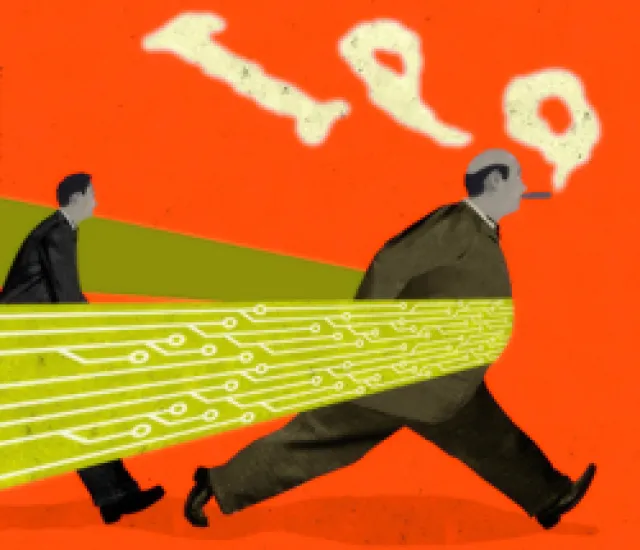
Just a few years ago, the New York Stock Exchange was an also-ran in the market for tech IPOs. Its platform was like a clunky old cell phone, compared with rival Nasdaq Stock Market’s iPhone. Though the NYSE was home to a few older tech giants, such as IBM Corp. and Hewlett-Packard Co., Nasdaq snared most of the notable tech IPOs of the past few decades, from Microsoft Corp. to Google, Intel Corp. and Oracle Corp. Yet market shifts can occur swiftly in the Information Age. A few months ago the NYSE surpassed Nasdaq in the tech listings market for the first time. The NYSE, which had a 12 percent share of all tech IPOs as recently as 2006, took 58 percent of the market for tech IPOs during the first half of 2011, according to Dealogic. The NYSE lured companies including LinkedIn and digital publisher Demand Media. Financial data management company Bankrate, computer memory start-up Fusion-io, digital music company Pandora, and Renren, known as the Facebook of China, also have listed on NYSE in recent months. Nasdaq came in second during the first half of 2011, with a 41 percent share as of July 19.
The NYSE’s gains didn’t happen overnight. They began several years ago with a strategic decision to pursue tech start-ups that had been ignored by NYSE in favor of larger and more established companies. To court them, the NYSE created a set of start-up-friendly alternative listing requirements in 2008, addressing a gap where rival Nasdaq had a huge advantage. The NYSE also invested heavily during the past few years in electronic trading, another Nasdaq stronghold. Then it brought in tech bankers to help sell the revamped NYSE and its still-potent brand, pitching CEOs of start-ups and rival companies that were listed elsewhere. The efforts appear to have borne some fruit. “NYSE has succeeded in making the tech IPO market a horse race,” says Lise Buyer, founder of IPO adviser Class V Group.
The NYSE and Nasdaq are squaring off in the tech IPO market at an important time, as a new generation of tech companies comes of age. Facebook is expected to go public soon, as are Groupon, Twitter, Zynga Game Network, and others. If the NYSE can capture some or all of those IPOs, it may retain its traditional identity as the Big Board, building its brand and attracting more companies that want to be in the orbit of the new giants. “We approach this market with humility, because it wasn’t that long ago that the NYSE was nowhere in tech,” says Douglas Chu, head of the NYSE’s Silicon Valley office, which handles tech IPOs and other business in the western U.S.
Chu, a former Credit Suisse banker, says the growth of the NYSE’s presence in the tech sector began in the fall of 2008, just as Lehman Brothers Holdings was imploding and the financial crisis was erupting in full force. As the markets and the economy crumbled, the NYSE decided to make a new effort to reach out to tech start-ups.
“I brought 12 tech companies public as a banker [in the ’90s], but only one even had the option of listing on the NYSE,” Chu says. That’s because start-ups couldn’t meet the listing requirements.
“The hope was that smaller tech companies would move to the NYSE as they got bigger, but that never happened,” he says. “It couldn’t have gone on that way. If it had, the NYSE would have died.”
The first step toward making itself more competitive was an overhaul of its listing standards. Instead of forcing start-ups to meet traditional income statement requirements, new companies were allowed to list on the NYSE if they had a minimum of $150 million in market cap, $75 million in total assets or $50 million in total shareholder equity. “Our adding a more accessible listing standard in 2008, certainly helped us by giving many companies an alternative,” Chu notes. That shift occurred under the tenure of his predecessor, Scott Cutler, now co-head of U.S. listings and cash execution at NYSE Euronext headquarters in New York.
The NYSE also moved heavily into electronic trading, an area where Nasdaq and other rivals were way ahead of it. Though that shift wasn’t specifically targeted at attracting tech start-ups, it made the NYSE generally more competitive. Since 2006 it has made a number of tech-related acquisitions, including Atos Euronet Market Solutions, Securities Industry Automation Corp. and Wombat Financial Software. It also acquired Arca, an electronic communications network, or trading platform, in 2007.
Once the gap in listing requirements and technology between the NYSE and Nasdaq were narrowed, the NYSE played up the importance of a still-potent asset: its 200-year-old brand. It has marketed itself to Nasdaq-listed companies and encouraged them to switch to the NYSE. In some cases the pitch worked. IMAX Corp., known for its giant-screen film formats, switched to the NYSE in February.
“We were approached by the NYSE. They made a case for why it would make sense for us to go with them,” says IMAX CEO Richard Gelfond. “They had a global platform and perhaps more history as a well-known brand. A lot of our peers listed on the NYSE, and they offered us marketing benefits we were not getting.”
Fees and listing requirements weren’t the key issue for IMAX, a 43-year-old tech company with more than $248 million of revenue in 2010. The main factor was that the NYSE offered to help promote IMAX — for example, including it in newspaper advertisements and a billboard in Silicon Valley. “They went out of their way to make us feel special,” Gelfond says. The NYSE also invited Gelfond to attend conferences with CEOs from China, a key growth market for IMAX. Of the 700 theaters the company has open or in development, 177 are in China.
Gelfond says IMAX’s investor relations department is pleased with the level of market intelligence that it receives from the NYSE. Chu says the market intelligence is a function of the NYSE’s direct market makers, who have roots in the traditional auction market. They use capital from their balance sheets to support the trading of NYSE-listed stocks; this reduces volatility and narrows spreads, according to Chu. “The companies also get one of the top traders of their stock as an additional information source about who is buying and selling their stock,” he says.
The NYSE also lured SuccessFactors, a software company that had been listed on Nasdaq. The San Mateo, California–based company, with $206 million in revenue in 2010, “did a concurrent listing on our NYSE Euronext platform to access more liquidity and increase visibility in Europe,” Chu says.
Nasdaq’s head of listings, Robert McCooey, says Nasdaq is still the home of tech companies and tech IPOs. “We don’t see ourselves as losing the tech market,” he says. As of July 31, Nasdaq had 13 tech IPOs for 2011, raising $2.43 billion, or 86 percent of 2010’s total. Among those companies was Yandex, the “Google of Russia,” which raised more than $1.3 billion. Other Nasdaq tech IPOs this year included learning software provider Cornerstone OnDemand, China data center service provider 21Vianet Group, mobile marketer Velti and real estate data source Zillow.
McCooey notes that plenty of NYSE-listed companies — such as BMC Software, Cypress Semiconductor Corp., entertainment company DreamWorks Animation SKG and computer memory maker Micron Technology — have made the switch to Nasdaq during the past two years.
He says that Nasdaq is the “gold standard” in equities listing and that the NYSE has grabbed market share by “lowering its listing standards.”
A Nasdaq spokeswoman says that the NYSE’s direct market makers provide less value than they once did, because the NYSE has reduced the amount of capital they are required to hold, from $1.8 million to $125 million.
McCooey, noting that Nasdaq is “still home to the biggest tech companies in the world,” says he isn’t going to match every promotional program offered by the NYSE.
“I have had a personal relationship with Richard Gelfond for years, and I think he truly felt like he was doing the best thing for his shareholders by taking the NYSE’s promotional package,” McCooey says. “But it would be tough for us to turn around and offer significant marketing packages to every single company that is on our market.”
When asked if he is doing anything to counter a specific threat from the NYSE, McCooey says, “I don’t sit around worrying about the NYSE as much as I think about the increasingly global nature of our business.”
Chu says he agrees with McCooey — to an extent — that the changes in NYSE listing standards were crucial to the exchanges’ recent gains in the IPO market. But those changes simply brought the NYSE in line with those of its rivals, and with those standards that are necessary if startups are going to be able to tap the public market. “Our listing standards were high enough that many tech IPOs did not qualify for the NYSE, so in fact, historically, Nasdaq has had no competition for many tech IPOs [and] was able to achieve a high market share simply because in many instances they were the one and only choice,” he says.
Can the NYSE’s gains in tech IPOs last? Its share has continued to grow during the past few years and shows no sign of slowing down. Of course, there’s no guarantee that it will hold on to its current lead in the market or attract big companies like Facebook, which is expected to go public in the coming year. Yet the market for tech IPOs, once clearly dominated by Nasdaq, is now hotly competitive and appears likely to remain that way.






